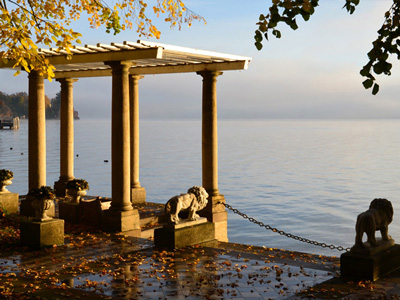
By ANDREW POWELL
Published: October 16, 2013
MUNICH — Some festivals strive to be on your radar twelve months of the year, with unending publicity. Others revel in a few days.
Take the annual Brahms Days in tranquil Tutzing, south of here on Lake Starnberg. Its scale is intimate, its setting gemütlich. Its focus — at least in theory — is on chamber music of the Hamburg composer, who penned his Haydn Variations and finalized his first string quartets during a long summer in the town.
At this year’s opening recital (Oct. 13), attended by state and federal dignitaries, Lena Neudauer and Florian Uhlig wove their way through violin sonatas of Beethoven, Ravel and Brahms in the Evangelische Akademie, a breezy former palace and U.S. Army HQ.
Neudauer’s confident, relaxed way with Beethoven’s E-flat Violin Sonata, Opus 12/3, emerged in burnished sound, gutsy more than sweet. Uhlig, on a small Steinway grand (perhaps a Model S), played loudly. Technically assured violin work in the Ravel Sonata in G Major (1927) — made amusing by Neudauer in its “Blues” movement and brilliantly sustained by her in its final measures — suffered again from stridency, this time on the part of both musicians.
An overlong intermission led into Joachim Raff’s syrupy reduction of Tannhäuser themes (from his Three Duos on Wagner Motifs, Opus 63), written six years after the opera. Uhlig must have discovered sensitivity during the break because now his playing took on a softer, more probing manner, and in the concluding Brahms work, the Opus 78 (1879), again in G Major, we heard a masterpiece masterfully realized.
Brahms Days programming this year has more depth than in 2012, but the festival still falls short of its potential.
Organizers plan around three Sunday evenings in the palace — with lake and Alpine views, savored by Brahms (and Eisenhower and others) — but this spacing, with funding for just five events, misses the chance to unite visitors and musicians in a vibrant and immersive exploration of the composer’s non-orchestral music.
Dilution of the schedule is matched by dilution in the programs. Tango, Brahms-based jazz (what?) and music by Heinrich von Herzogenberg (who?) have found a place in Brahms Days during the last five years. Yet of Brahms’s two dozen sonatas, trios, quartets, quintets and sextets — works of genius — only nine have been heard at the festival in the same long period. Brahms’s art-song output has fared better, with full cycles of the Magelone-Lieder, the Zigeunerlieder and the Vier ernste Gesänge. But not his keyboard music, equally suited to these events.
Checklist of the missing: the popular horn trio, all the piano trios, three sonatas, two of the three string quartets, the four luminous late collections of piano music, and dozens of songs.
Tutzing offers several venues, agreeable fall weather, a bona fide Brahms connection, and a ready audience from Munich and elsewhere. With imagination, the present runs of recital dates could evolve into a unique (and world-class) annual gathering.
Photo © Evangelische Akademie Tutzing
Related posts:
Brahms Days in Tutzing
A Stirring Evening (and Music)
Salzburg Coda
Plush Strings of Luxembourg
Kaufmann, Wife Separate
Tags: Beethoven, Brahms, Brahms Days, Brahmstage, Evangelische Akademie, Florian Uhlig, Haydn Variations, Joachim Raff, Lake Starnberg, Lena Neudauer, Ravel, Review, Schloß Tutzing, Tutzing